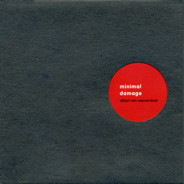
Albert van Veenendaal
Minimal Damage
(Evil Rabbit Records)
An assured, multi-style approach; highly developed instrumental skills; great
variety of line-ups; and an exuberant productivity are some of the features
of the music by pianist and composer Albert van Veenendaal. Which, in a
way, is something to be expected, given the fact that van Veenendaal is
a Dutch fifty-something.
Among
the titles in his discography that I liked the most (only talking about
the tiny slice of van Veenendaal’s releases that I happened to listen to,
obviously, as it’s to be expected when one’s output is so large) two that
I frequently return to were recorded by various line-ups: released a few
years ago, one – quite bizarre – goes under the name President Of The Globe;
while the other – a very fine album titled Midday Moon, released last year
– features a quartet.
Then
there are the titles released on Evil Rabbit Records, the label van Veenendaal
established in 2006 together with double bass player Meinrad Kneer to offer
a better documentation of his work. Here I have to say that, though I like
quite a few of the albums he has released on that label featuring his own
work, no title has struck me as being really excellent, the opposite being
true of Minimal Damage.
One
trait that I think is really special in van Veenendaal’s work is his regular
use of the prepared piano; an instrument that, as per this album’s subtitle
– Miniatures For Prepared Piano – is the only character here.
Many
styles, of course, some of them being now just a memory: listen to the
version of the Mingus-penned Goodbye Pork Pie Hat, which at first I recognized
only because its title appears on the CD. There’s also a long history to
the act of preparing the piano, as demonstrated by the only track recorded
way back in 2007: featuring a dark, menacing theme, Dark Days & The
Moon is immediately recognizable as a prepared piano, buzzes and all.
All
the other tracks featured on this album make use, in different ways, of
overdubbing, and a "modern"-sounding mix rich with echo and reverb.
Hence, timbre and notes which equally contribute to the final result.
Here
I think van Veenendaal has looked in the general direction of minimalism;
better said (a few minimalist traits appearing here and there anyway),
he has looked in the general direction of those "oriental" strains
of music that were such important an influence for the first practitioners
of minimalism. Hence, we can hear metals, marimbas, and assorted percussion
(but it’s always a piano we listen to), playing melodies that can often
sound
"ethnic". Sporting a great control in both the playing and composing
dept., the work easily avoids the danger of sounding "watered-down".
This is an album of substance which also sounds surprisingly accessible (I
think!).
First
track The Spy & The Vampire (the only long track here, together with
the title-track), has a "literal" development: left-hand ostinato,
right-hand chords, a melodic, "film noir" theme, a new "picture
for marimba" appearing at 1′ 40", a "horror" splice
(with sampled voices?) from 2′ 40" to 3′ 40", variations, theme.
Percussive,
lively, Tear Dance is a good example of the "layered" approach
often featured on the album. Frog Dance sports a carillon and an arpeggiated
melody. Mechanic Mushroom sounds quite "ethnic-minimalist", percussive,
with a fine, simple melodic theme. Pirouetteke almost sounds as if programmed
on a sequencer, with circular arpeggios, nested odd-meters, and nice volume
dynamics (also a pinch of ragtime?). Marimba and percussion are back for
Daily Values, while Sea Monkeys features wood and metal percussion, with
heavily reverberated single strokes.
Minimal
Damage could maybe be files under "acoustic funk", with distant
echoes of Herbie Hancock’s Head Hunters, a "pigmy dance" for
percussion and flutes. The slow, melodic, Old Frogs and Histoire Pneumatique
both feature the "marimba". Whales features "whale sounds"
and a lot of work on the piano strings. Transition (in its own way, quite
jazzy), Zen Gardening, and Slow Boat are the fine close for a work of perfect
length: 41′ 19".
Beppe Colli
© Beppe Colli 2010
CloudsandClocks.net | Nov. 16, 2010


